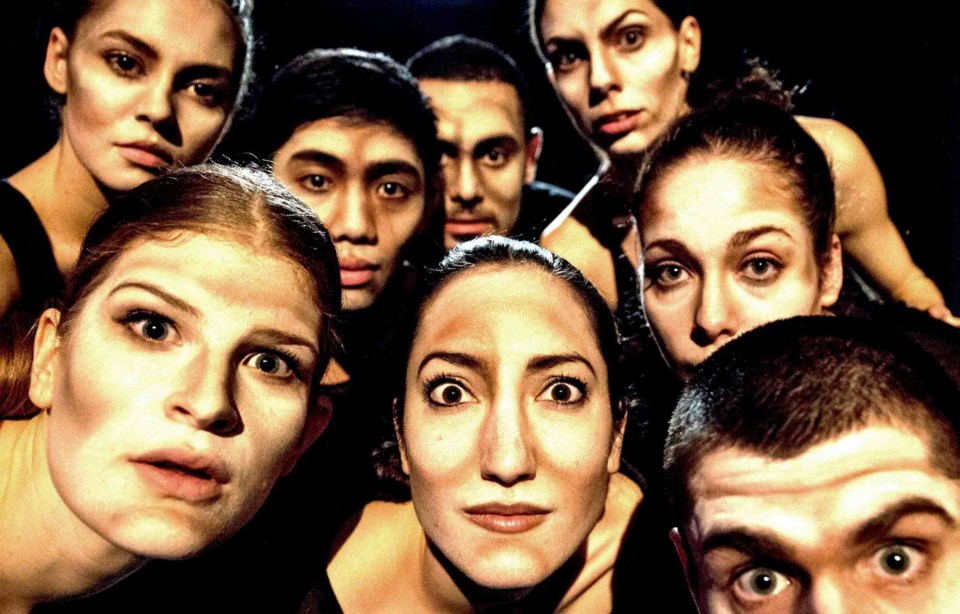Major Motion Picture by Out Innerspace Dance Theatre
Where: Metro Studio
When: Jan. 29, 30
Rating: 4 (out of 5)
—
Vancouver’s Out Innerspace Dance Theatre has attracted national attention of late for its innovative, cutting-edge contemporary dance. This weekend, as part of Dance Victoria’s Dance Days festival, the company staged the world première of its latest piece, Major Motion Picture.
It’s an intriguing, ambitious and — at times — highly original work. Created by company leaders David Raymond and Tiffany Tregarthen, Major Motion Picture presents a murky Orwellian world that sometimes seems like a Hieronymus Bosch painting come to life. There’s an oppressive atmosphere of human despair (and fleeting hope) amid Big Brother surveillance and mass-media oppression.
The two-part dance ends rather arbitrarily on a redemptive note. But what preceded this during Friday night’s powerful performance seemed like a glorious nightmare.
Performed by Tregarthen, Raymond and five other sharply rehearsed dancers, Major Motion Picture is on one level a struggle between two gangs. One, dressed in black, often functioned in harmony, moving in a seething intertwined mass that simultaneously suggested cohesion and angst.
The other sported striped bodysuits with matching balaclava-like hoods. This gang seemed marginalized. Using infrared cameras to project images on a large backdrop, the striped dancers were often seen in the wings, like a population existing on society’s fringes. Their movement was more fractious than that of the harmonious gang. In Act II, four stripers paired off for pas de deux that recalled martial arts combat.
Cinema, particularly German Expressionism, is an influence on Major Motion Picture. Several times, a giant claw-like hand was projected menacingly behind the dancers. Another black and white video clip showed dozens of dancers moving in a wave from left to right, while a frightening white-masked face (monster? alien?) sat immovable.
The orchestral music of Bernard Herrmann, known for his collaborations with Alfred Hitchcock, features prominently in this work. Elsewhere, we heard thudding hip-hop bass-and-drums, or merely pared down drumming .
One of Major Motion Picture’s enduring images is a giant black overcoat. Peopled by three dancers, the coat lurched about, headless and disturbing. Toward the end of the dance, the coat-monster — perhaps representing a corporate overlord — devoured one dancer headfirst.
This was skilfully danced. Even more remarkable was a giant monstrous face reminiscent of King Kong or some other beast. It’s a magnificent piece of theatrical sleight of hand. This apparition made terrible sounds reminiscent of the audio-overkill sound effects found in action movies.
Technical effects, particularly projections, were used in a seamless, even virtuoso manner — sometimes it was hard to know what was live and what was merely being screened. A dancer appeared to spray graffiti on a wall: “Keep them in the dark.” Such high-tech flourishes contrasted with low-fi touches such as a scratchy sample of Skeeter Davis’s 1962 teen-angst ballad End of the World.
Out Innerspace Dance is obviously onto something here. The dancing is athletic, satisfying and accomplished. At best, Tregarthen and Raymond’s vision is jaw-droppingly original — you will see things in Major Motion Picture you have never experienced before. This is bold and exciting contemporary dance.
That said, it’s a work that could use further workshopping. The length of the dance meant inserting an intermission, which interrupts the flow. The first half is 50 minutes, the second about 30. It appears the work might be trimmed and streamlined.
Act II seems more jokey and literal than the Act I, which is stronger. There’s a sense that more refining is in order. The final image, a mother cradling a child, is obviously meant to end Major Motion Picture on a hopeful note. But given what’s come before — abstract, visceral and challenging — it seemed a slight letdown.



